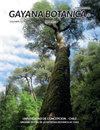Accumulation of heavy metals and minerals in soil rhizosphere and organs of Parkia biglobosa and Butryospermum paradoxum growing at the lead polluted site in Niger State, Nigeria
IF 0.5
4区 生物学
Q4 PLANT SCIENCES
引用次数: 0
Abstract
Anthropogenic activities inducing the accumulation of trace elements in Madaka village (between latitudes 6°00' E and 7°00' E, and 10°00' N and 10°04' N longitudes) of Rafi Local Government Area (Kagara, Niger State, Nigeria) have claimed many lives in the past. This study evaluated the accumulation of heavy metals and minerals in Butryospermum paradoxum and Parkia biglobosa and their soil rhizosphere at the lead polluted site around Madaka village of Rafi Local Government Area (Kagara, Niger State, Nigeria). Lead, arsenic, pH, nitrogen (%), organic carbon (%), organic matter (%), P, K, Na, Ca, Mg, N and cation exchange capacity were determined. Results showed significant differences (p < 0.05) between the Pb content in the soil from control (3.13 ± 1.010 mg/kg) and polluted sites (12.71 ± 1.010 mg/kg), and in the seeds of Butryospermum paradoxum from control (3.80 ± 0.09 mg/kg) and polluted sites (13.10 ± 0.10 mg/kg). A significant (p < 0.05) difference was also observed between the Pb content in Parkia biglobosa seeds from the control site (2.50 ± 0.10 mg/kg) and from the polluted site (14.10 ± 1.10 mg/kg). Overall, no significant differences (p > 0.05) were observed in the nutrient contents among all samples analysed. A significantly high concentration of Pb and As in these plants around the lead polluted site poses a great health concern. This calls for the public’s attention, both governmental and non-governmental organisations, to intervene by creating awareness of the likelihood of their bioconcentration in humans and animals that consume these plants.尼日利亚尼日州铅污染场地大叶枇杷和异叶枇杷根际土壤和器官重金属和矿物质的积累
在拉菲地方政府区(尼日利亚尼日尔州Kagara) Madaka村(纬度6°00′E至7°00′E,经度10°00′N至10°04′N),诱发微量元素积累的人为活动在过去夺去了许多人的生命。本研究评估了拉菲地方政府区Madaka村(尼日利亚尼日尔州Kagara)附近铅污染场地的异黄草(Butryospermum paradoxum)和大叶枇杷(Parkia biglobosa)及其土壤根际中重金属和矿物质的积累。测定了铅、砷、pH、氮(%)、有机碳(%)、有机质(%)、P、K、Na、Ca、Mg、N和阳离子交换容量。结果表明:对照地土壤Pb含量(3.13±1.010 mg/kg)与污染地土壤Pb含量(12.71±1.010 mg/kg)、异胚子Pb含量(3.80±0.09 mg/kg)与污染地土壤Pb含量(13.10±0.10 mg/kg)差异显著(p < 0.05)。对照区大叶枇杷种子Pb含量(2.50±0.10 mg/kg)与污染区大叶枇杷种子Pb含量(14.10±1.10 mg/kg)差异显著(p < 0.05)。总体而言,各样品营养成分含量无显著差异(p > 0.05)。铅污染场地周边植物中铅、砷的浓度明显偏高,对健康构成严重威胁。这需要公众的关注,包括政府和非政府组织,通过提高人们对食用这些植物的人类和动物体内生物浓缩可能性的认识来进行干预。
本文章由计算机程序翻译,如有差异,请以英文原文为准。
求助全文
约1分钟内获得全文
求助全文
来源期刊

GAYANA BOTANICA
Agricultural and Biological Sciences-Plant Science
CiteScore
0.70
自引率
0.00%
发文量
8
审稿时长
6-12 weeks
期刊介绍:
The journal welcomes works carried out by scientists of all nationalities, and may be written in either English or Spanish. The journal receives works in systematic, taxonomy, floristic, ecology, physiology, morphology, development, conservation, cytology and phytochemical botany.
 求助内容:
求助内容: 应助结果提醒方式:
应助结果提醒方式:


